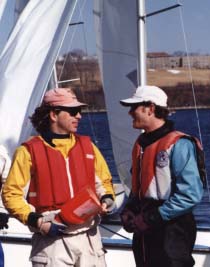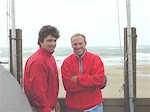Peter Alarie: Sailing from where you are |
|
Peter Alarie is good. How good? He could be the most successful 505 crew of our generation. He's won eleven 505 championships in North America since 1988. And he has done so with seven different skippers. In short, he's been the common denominator in more than a half dozen winning 505 campaigns.
And he has built a career on more than speed. Few match Peter's expertise in boat work with skills acquired through careers in cabinetry and boatbuilding. On the water, Peter combines superb boathandling skills, tactical mastery, and winner's attitude. Howie Hamlin has described Peter's sailing mentality this way, "calm aggression".
At 33, Peter isn't a kid anymore, but he's still got a lot of the kid left in him. This was painfully obvious to me at a go-cart track in Falmouth during the 2000 New England Championships. With six of us revved up on the track, Peter suggested team race with only one rule - no rules. While most kids are content to just smash into each other randomly, Peter's strategy included double teaming, side-swiping, and hat grabbing. After we were "asked to leave" the track by the teen-age employees, Peter showed quite a knack for arcade games, especially the ones that involved killing things. From there, it was off to the batting cage. Our particular pitching machine had run out of balls, so a few of us decided to speed things up by assisting an employee with loading the machine. Peter turned this exercise into a dodge ball game, thus precipitating our departure.
To the less acquainted, Peter might come off as a tad bit arrogant. As a coach, he'll flatly tell you why you're slow or why your crew work stinks,and he does so in tone that makes you believe that his observations should be obvious to the most casual observer. He just doesn't sugar coat anything, and sometimes the truth hurts. But Peter didn't get to be champion by lying about his own performance, and if being brutally honest is trademark of arrogance, I don't think Peter really minds that label.
Teamed with Howie Hamlin for the 2000 505 Worlds in Durban, this may be Peter's best chance to win a worlds, and he isn't taking this opportunity for granted. Peter is absorbing the best thinking and techniques developed by West Coast 505 sailors. Ironically, distance may also be working out to his advantage in that communication, planning, and time management all factor in heavily when you are separated from your partner by 3000 miles.
In his relentless quest to improve his sailing skills, Peter seems to have realized that his greatest competition may be himself. I interviewed Peter by e-mail.
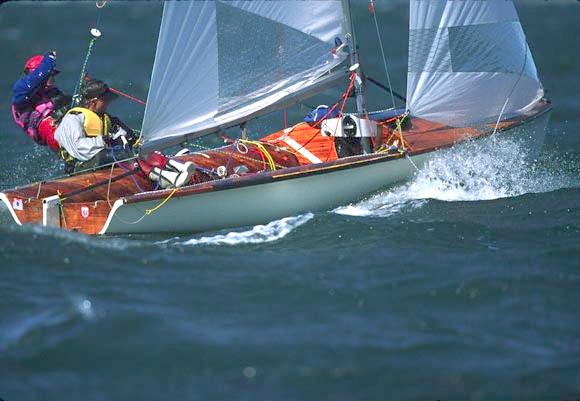
Peter and Mike Zani at '98 Worlds in Hyannis.
JESSE FALSONE: With Cam Lewis busy with his syndicate for "The Race", you teamed up with Howard Hamlin for 2000. Is this serendipity for you and do you believe in fate? How long did it take for you to commit to the whole program with Howard?
PETER ALARIE: I was pretty psyched when Howie called me about sailing the Worlds this year. How could you not be? I don't know about the fate issue. I think that is bit of a stretch. It's more just being in the right place at the right time. I don't really believe in fate. But as a rule, I like to leave my options open and I love to do things on a whim - to change plans if something cool comes along. My work has allowed me great flexibility with sailing plans and such, so people tend to call me at the last minute to fill in. Brad Read once remarked that he had more luck getting me to sail if he called me the day before an event, rather than two months ahead of time. Well, Howie did just that for last year's PCCs when Cam got caught doing some other deal at the last minute. We were both nervous about sailing with each other. There were lots of expectations, but we were immediately comfortable in the boat,and we sailed very well at the regatta, winning something like six of nine races! At that time I planted the bug in his ear about sailing the Worlds together, but he was still signed on with Cam. I just waited out the situation, and when Cam got his funding in line for The Race, Howie and I inked the deal.
JF: Sailing with Howard on the West Coast has meant lots of travel. Other than sailing with the current world champion, is there an upside to this type of long-distance campaign?
PA: I would say that one of the upsides to this type of campaign is that we are very focused when we do get together. We e-mail a lot about ideas, goals, things to work on, and feedback from the sessions. On typical weekend, I fly out on Thursday morning, we sail Thursday afternoon, boat work on Friday morning, sail Friday afternoon, race Saturday and Sunday, then I fly home on the redeye. We have had at least one other boat out each sailing day and try to get a coach out as well. Knowing that we have limited days to train really forces us to have it together, establish clear goals and to push extra hard when we do get out on the water.
Also, by staying in touch between sailing sessions, we both find that when we do sail, it seems like we have improved in the time off. Howie sends me their weekly updates and training schedules (they sail every Tuesday evening in Long Beach with 3-6 boats), so I feel like I am part of the training, learning what they learn, even though I am not present. I also find that I am visualizing more than I have in recent years, something I used a lot sailing the Flying Dutchman and in college. When we talk about things or techniques, I am going through it in my mind, and when we get in the boat three quarters of the work is done. This really works well for me, but I think that I needed the new challenge of sailing with Howie to get me back into it, to provide the inspiration to get better, to learn new techniques and a whole new sailing style.
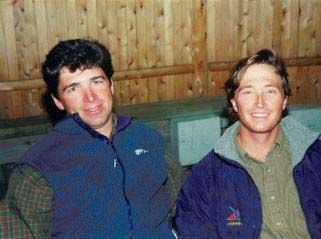
Peter and Mike Zani.
JF: With all the collective sailing experience between you and Howie, it's hard for new sailors to imagine what you would have to improve upon. What would a typical goal list look like for your team during a weekend practice session? How do these differ from goals you make for a regatta?
PA: Once each team member gets to a certain level of sailing, then you can look at the improvements coming in the form of actual teamwork.While you can always get better at doing any one maneuver as individuals, the gains that you can make as a pair are where big gains can be realized. There are both types of improvements that we work on. Take tacking for example. We can each get better at our job, and we can also improve together the timing, the flow and the consistency. You can fine tune the movements as you get better, with the end goal being that each tack is very good, no matter what the conditions, how many boats are around, how much pressure is on making this one tack. You want to know that in 25 knots, with a boat tight on your hip, that you can tack and cross that guy no problem. That can sometimes be the difference between top five and top 25 in big race. There is also a level of confidence that this type of preparation brings, and that cannot be underestimated. When you know that your tacks are the best, you know that is a weapon in your pocket. I guess what I am talking about here is being able to sail the race without ever considering what it is that you are doing in terms of boat handling. You are not afraid to gybe two times in 10 boat lengths in 25 knots if it means you have a chance to pass someone. You do not consider the moves. You just execute what it is that you think you need to do. Boat handling is an element of sailboat racing that you have total control over. Not many of the other elements of our sport are like that. If you want totally bad ass boat handling, then go out and get it! We work on it constantly, and our goal is to always be able to pass someone just by doing a maneuver. That is a pretty big weapon-thinking or knowing that by simply gybing, you have a very good shot at passing the boat in front of you.
THE COMMON DENOMINATOR
What do Macy Nelson, Mike Zani, Howard Hamlin, Tom Kinney, Zack Leonard, Karl Zeigler, and Neal Fowler have in common?
All seven championship-winning 505 helmsmen have sailed with Peter Alarie - three for long-term campaigns. Other skippers benefiting from Alarie's services: Dave Dyson (second at '91 NAs with Peter), Chuck Allan, and Allan Kruger.505 CHAMPIONSHIP TITLES
North American Championships - '93, '94, & '97
East Coast Championships - '95
Pacific Coast Championships - '99, '00
Midwinter's (East Coast) Championships - '88, '89, '93, '98
New England Championships - '00FAVORITE SAYINGS
"Fly a hull!", "She's luscious", "It's like butta", "Spook the Heard", "That's so East Coast"So, as far as goals go,when we are practicing by ourselves, we work relentlessly on boat handling, as this is the best use of our time. In between drills we will work on just sailing a point of sail, but the overall focus is on smoother handling. We also take notes on what our problem areas are and work on that. Always try to improve your biggest weakness first, then work on the stuff you can do okay. While practicing with other teams, we work on speed or racing, as this is best use of a group. We often find that we can combine boat handling in a group session by simply getting on the water 20 minutes early. You can do a lot of tacks and gybes in 20 minutes!
Goals at regattas are different. My goals usually revolve around trying to compete well. I like to finish a regatta and feel really good about how we sailed, regardless of the outcome. For example, we won regatta in Santa Cruz, but neither of us was that psyched about it. We won because we did not make any mistakes and passed many boats with boat handling, but we were let down because we were not that fast and we were a bit asleep tactically. But we looked at what happened, and made fair assessment of our performance. We won because other teams screwed up, not because we were the best team that weekend.
JF: You mention a whole new sailing style. You 've been sailing the 505 at the top of the fleet for a decade, so one would assume you're set in your ways. Can you offer us a specific example of a technique that you changed and how it had a positive effect on your sailing?
PA: I have completely changed all of my crewing techniques in the 505. I now tack by hooking in on the tank before going out on the wire after years of going out on the handle. I am also a huge fan of the so called "skiff gybe", which is what Howie and I do now. Both of these changes are aimed at heavy air sailing.Tacking on the handle is still better in marginal trapping, as you have a better feel of how much weight to throw onto the wire, and you can swing in and out quickly. The skiff gybe is awesome, and you really need to experience it to believe how easy it is. You must have a fork end and a smooth working pole launcher for this to work. Each element of the gybe has been worked out, and if you leave out a step, it will not work. Before a gybe, Howie cleats the windward jib sheet with no slack in it and throws the pole launcher line overboard in front of the trap shock cord. The end of the launcher line must be loose. When we go to gybe, I uncleat the leeward jib sheet, Howie then finds a good wave, I unhook from the wire,and say "ready!" Howie then turns on the wave at full speed, as you would gybe a Laser. I swing in and uncleat the pole line as if my life depended on it (and sometimes it does!). I have my launcher cleat on the mast, with the cleat facing down. The pole rockets back and we carve the turn on the wave. We turn so fast that the chute rotates itself, with Howie only grabbing the new sheet after the boom is over and he is hiking on the new side. As the boom comes over, I switch the twings with our two handle system, stand up and launch the pole. When done to perfection, you can get the pole out fully before the chute really loads up (you have slowed down the turn, but you are still turning up towards the reach), grab the new sheet from the skipper and over the side you go. Make sure to wave at the boat you just rolled!
If you want totally bad ass boat handling, then go out and get it!
JF: I'm very interested in your visualization technique. Do you go through this exercise only in your mind, or is there a physical element?
PA: Every male over the age of 12 already knows all about visualization. We do it all the time, and not just in the bathroom anymore! You simply imagine what it is that you are going to do, step by step, before you do it. You can work on your tacks during your lunch break by simply closing your eyes and going through the motions, breaking it down to the finest detail. I am told that this is not just a mental exercise, but that you are actually mapping the nerve firing patterns by doing this! What this means, and I have seen the results, is that if you spend a few minutes each day thinking about your tacks, the next time you get in the boat, it will be like you have done 50 extra tacks in the time off! I will often do this during a practice session, especially if I am having problems with some element of a maneuver. Before you do the maneuver the next time, run through it in your mind, step by step. It can help you find the problem area, and it will make the next one smoother. I figured out a foot placement problem mid session by going through all of the possible placings in my mind, between tacks. By the time we tacked again, I had found the best placement for my feet, and the tacks were much better.The only real negative that I can think of is that I am a bit competitive with everything I do, and I expect to do well.
JF: What's the most important ingredient in the success of a 505 team, and how is this ingredient developed?
PA: It's tough to say what the most important ingredient is. Desire is probably the most important factor. The will to improve can overcome all of the setbacks and disappointments that you experience on the way towards your goals. Howie has tremendous desire to do well, and this was certainly a factor in his 20 year quest to win the 505 Worlds. Desire keeps you focused when things are down, and can give you the strength to persevere. How do you develop desire? I guess you just have to decide for yourself that you care enough about 505 sailing to give it your best all the time. Some people just do not have it, and that is totally fine. But these people will be saddened to learn that they will never win in this class with a half-hearted effort; there are too many talented sailors that have burning desire to kick ass.
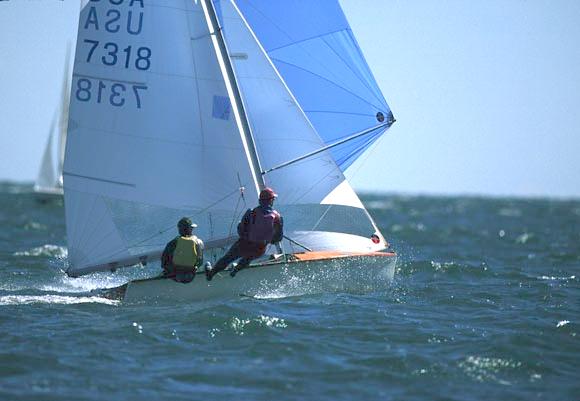
Worlds '98.
JF: How has your success in competitive sailing enriched other areas of your life? Has it had a negative impact on any areas? I made a choice a long time ago with my life. I decided that I would never have a job that would prohibit me from going sailing (or any other activity) as much as I wanted. I have never regretted this choice, and in fact, I feel that it has made me generally more happy than I might be if I was working in some office with only 10 vacation days a year. This has enabled me to race and sail a ton, which has in turn led to competitive success. So it is a bit of a backwards relation, but I do feel that sailing has made me happier, especially being able to blow out of work on some ripping afternoon and fly a hull around the bay!
The only real negative that I can think of is that I am a bit competitive with everything that I do, and I expect to do well. I find that I really have to make a conscious effort to just chill out and enjoy things sometimes. What I do now is announce to myself that "this is just for fun, so ease up!" I did this 55 mile catamaran race around Narragansett Bay last weekend. Total hack event, but it was really fun! We showed up late, casually rigged up, and just went for cruise. Blazing along, flipped with the kite up, whatever! Good stuff.
JF: There have been a number of talented young sailors who have jumped into the class with unreasonable expectations. As a result, many have dropped out after a short time. In what ways does college sailing prepare you for a boat like the 505? In what ways are college sailors generally unprepared for the 505?
PA: I think that college sailing is great for teaching you how to sail boat on boat and tactics on the short course. You also see some of the better college kids get pretty good at kinetics, which can translate to other boats like the 505. Other than that, it does not do as much for our young sailors as everyone thinks. College sailors learn nothing about boat preparation and maintenance. In fact, it often seems like these kids end up with absolutely no respect for boats and how to care for them. They also learn very little about sailboat tuning and the elements that make boats go fast. I think this is a huge problem with our junior/college sailing programs that have been set up in the US. These young sailors can race hard for 10-12 years, attending national level events, and never sail in a boat with a bendy mast that is capable of planing upwind! This type of sailing is fine for college and high school style racing, but when our juniors are sailing the same types of boats all summer long as well, that is a problem. The whole Club 420 movement should be stopped right now. It is making our juniors suck. The boats are 50 pounds overweight with a totally unresponsive mast. There is no development or tuning to speak of. These boats are so bad that in moderate air, it is faster to hike than to put your crew on the wire! These same kids, now three time All Americans, then show up in a 505 and get just killed by people they have never heard of! No wonder they get frustrated. They have an idea that they are pretty good at sailing, when in fact they have just scratched the surface of what is out there. The ones with the desire, the real desire, not coach inspired confidence, dig in and figure it all out. The others go and sail keelboats, where their sailing knowledge translates (slow boats, unresponsive rigs), or they drop out altogether.
We really need to get the young sailors into boats that have a performance level that will challenge them and show them what makes a sailboat work. I started sailing 505s as a freshman in college, and it was the best thing I ever did for my sailing career. All of a sudden I had a clue about tuning, weight movement, and what it took to do well in this type of boat. It took a while to succeed in the class, but once you can make a 505 go fast, you can get onto any boat, anywhere and make it cook.
JF: Like many people, some of your earliest sailing experiences were on a Sunfish. How did these experiences influence your path in sailing? What other early experiences drove you into competitive sailing?
PA: I took to sailing very quickly when I was young. I did a bunch of reading before I went sailing for the first time, and as result it all made perfect sense to me. I was moved into the advanced class after the first week and the advanced class was all about racing. I won the first regatta I entered, NBYA Junior Race Week, where I sailed Sunfish Doubles with my friend Chris Plant. I raced locally for several years, winning bay championships, and was then given the chance to sail in the Youth Nationals in 1983. I did not do that well, finishing 37th out of 50, but it was great exposure for me, and showed me that I was indeed a small fish in the big pond.
I think the period that I learned the most was during my college years, when I sailed a ton in just about every boat I could get on or in. We didn't have a coach at Yale, so the team was self run. Basically a group of us decided that we wanted to get good, and we worked hard to achieve that. I started sailing 505s and FDs, which was a real eye opener! I give my good friend, Zack Leonard, a lot of credit for helping me refine my sailing during this time. We were fierce friends, competing against each other and working to improve.
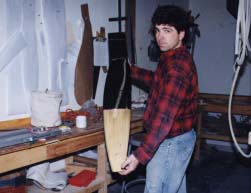
At Guck, Inc., with high-aspect 505 rudder.
JF: I get the feeling that your campaign with Howie is much different than any other you've been involved with in the past. Is this a true statement? If so, what is different about the campaign and how you have personally approached it?
PA: Howie is just very organized and driven. It was a very easy program to jump into, and I am very thankful for the chance to sail with him. We have a lot of fun. It is just so easy when you have your shit together, and you can focus on enjoying the time on the water. Howie has many years of experience, but I think that where he is the farthest ahead is in the shoreside logistics. There is a system for everything, and everything has been trimmed down to the bare minimum. He does not have big tool box or a lot of extra stuff, but we always seem to have just what we need.
It is interesting to see the California side of the 505 scene. We sailed a lot with Nick and Mike leading up to the 1998 Worlds, but our approach was totally different. We were not as focused in our approach to anything, we just sailed together a lot. We developed speed, but it seems like it was more by chance. We always tuned by feel, while Howie tunes by the numbers. He keeps track of what has worked in the past, and goes back to it until it is proven wrong. We would change things around until they felt fast, and then check out how we were going. When we talked during a tuning session, we would be talking about this "feel". "Does the boat feel loose/bound up, main driven/jib driven, can you pull the bow down and accelerate, or do you tip over..." When I first started sailing with Howie, I would ask him how the boat "felt", and he would say,"I don't know..." It seemed like he had never really considered that as criteria for tuning. Interesting, I guess.
Personally, I am just psyched for the chance to learn even more about 505 sailing and sailing in general. I think that it is really great to get out and sail with as many people as you can. I always learn by getting in the boat with someone new, even if you do not think that they are very good. They may ask you a question, and in answering you may discover something about what you thought was true. In having to explain, it forces you to have a deeper understanding, and you may find that you really have no good reason for believing something that you have held true for years!
JF: I've heard that you have threatened never to sail keelboats again. Would you consider sailing in an America's Cup campaign as a professional?PA: In fact I do not sail keelboats anymore. People call me, and I say that my day rate is $400 plus expenses, and they tell me to get lost! No one really knows who I am outside of the dinghy world, so they are not prepared to pay me to sail. I think keelboats all suck, so I will not go out with them unless I am paid. It all works out very nicely!
The AC thing is sort of interesting, but I do not think that I would thrive in that environment. I would have the same attitude that I have with other keelboat sailing, and I am sure that I would get the same reception. It is so political I am not sure I could handle it. I think I would have more fun running the logistics of a program like that and just stay out of the crying game on the boat. The sailing just does not look that fun. I would rather fly a hull.
JF: When you say "fly a hull", I assume you are referring to sailing you 're single-handed A Class Catamaran. Is it more fun for you to sail alone or on a boat with a good team atmosphere?
PA: "Fly a hull" is an all-purpose remark that we use in a lot of situations, much like the well known "forgetaboudit". When you go smoking by a rail full of keel boaters you say "fly a hull!" Want to go sailing, "let's go fly a hull!" Saying goodbye to a friend, "hey man, fly a hull." It works in a lot of situations! Anyway, I do really love A Class sailing, although I have been without a boat for almost a year now. We have other cats at the shop that I sail quite a bit, and they are all very fun!
JF: Describe your pre-race routine that helps you establish the best mood for competition? Do your target moods vary depending on the conditions?
PA: This is a very interesting topic, one that most people do not have a clear understanding of. Your level of stimulation is very important to how you will perform in a competitive environment, and it is different for everyone. If you are too "excited" or "up" you will not perform well, you will have vague focus, and you will not be able to execute as smoothly as you are capable. You will also be prone to loose your shit if something goes wrong, missing other opportunities to gain. The opposite is true if you are under stimulated. You will not have the fire to roll over the guy to leeward, and you may miss split second opportunity because you are not in the game. Everyone's ideal level of stimulation is different, and you can only really tell where you should be by trial and error. When you have a good day, think back on your mood starting off, and try to get back to that place the next day. Once you find your zone,stick to the routine that got you there, including diet (food, coffee), timing (rushed or leisurely) and interaction with other people and boats.
For me, I like to be relaxed and focused before a race. The way I get this state varies, but in general I like to be early to the course, just sail around for awhile, do some tacks, set, a few gybes, takedown, and then talk about the conditions and what we see on the water. I do not like to tune before the race with other boats, as I feel this only distracts me from my job, which is to figure out the conditions and what we are going to do in the upcoming race. We will tune with others, but this is more for Howie, and I try not to get too involved with our setup. My feeling is that we are not going to learn something new 10 minutes before the start, and we may well just get freaked out about our setup, thinking we are slow. The only thing I really care about is that we will be fast enough to race up the first beat. I know that in general we have this kind of speed, so I just do not want to think about it. Hitting the first shift or being on the correct side of the beat is much more important to me.
As far as different conditions, my moods do vary a bit. I used to really hate light air, but I got into it by changing my attitude, thinking of it more as a chess game, trying to out fox and out maneuver the other boats. I get into being really still and trying to really feel the boat and find ways that I can make it go faster, find more wind, or just figure out what may happen next. In heavy air, it is more of a thrill ride and you can let the adrenaline take over bit (but not too much!). This is more of the gear jamming mentality, where you just try to grind down the opposition, or get past them with an explosively perfect gybe in that gnarly puff. But underneath, there is still that focused calm, where you just do not get rattled, you just keep doing your best. Jonathan McKee used to coach us in the FDs, and his mantra was always "no matter what happens, you've got to race from where you are." Pretty sound advice, and it helped me control my temper and stay in the game, no matter how bad I may be doing.
JF: Can the 505 continue its success well into the 21st Century? If so, how?
PA: I think the 505 is a very balanced and exciting boat, and that is the reason that it has survived so well. I am not sure what will keep it going or kill it, but there sure seem to be a lot of opinions out there. The large spinnaker movement does not have me convinced, but I have not sailed with one. Tight reaching is certainly one of the features of the boat, and I would be wary of moving away from this. If we go with bigger kites, we will have to sail deeper reaches, and that just may not be as cool. My experiences with the A Class have shown me that lighter weight is a good thing, and the switch to carbon rigs needs to happen. Aluminum is a bad material for a mast, and we should all just suck it up and figure out how to make carbon masts work with our existing fleet structure.
It would also make sense to slowly take weight out of the boats. If we could be racing around in 220 pound boats with carbon masts, we would not need bigger kites! But who knows, changes like that could just kill the whole thing. It does not seem like there is much wrong with what we have now. Is change necessary for the future success, probably so. Looking ahead 50 years, the 505 will seem like a Snipe if it is totally stagnant. Make it lighter, and it will always seem modern.
JF: Are you determined to sail the 505 until you win a World Championship?
PA: I do not really feel any pressure to keep sailing 505s, or any other boat, for a goal like that. There is so much that goes into winning a regatta of that caliber, it all has to be right. Being the best team is not always enough, you have to catch some breaks and be fortunate to avoid the weirdness. As with any other type of sailing, I will keep doing it as long as it is fun. I no longer feel that I have anything to prove, so sailing is competing with other things for my free time. The thing that is the most fun wins out in the time lottery. I have been getting into cat sailing a lot. That has really inspired me on the sailing front. Probably the best race I did last year was a cat event that raced around Key Largo, 110 miles over two days. The second day we tight reached 44 miles up the bay side of the Key, following dodgy channel markers, weaving through reefs and over sandbars, paddling through mangroves. When we got the finish line, I could not believe it; I thought we had 20 miles to go! Average speed for the leg was over 20 knots, and we were literally paddling for about 12 minutes of the 2 hour 10 minute elapsed time! After a race like that, you realize that there are a lot of really fun things out there!
Will I continue to sail 505s? You bet. We are rigging up a new boat at the shop, and I am sure I will be sailing with someone next year. The boats are just too much fun!Jonathan McKee used to coach us, and his mantra was "no matter what happens, you've got to race from where you are".
|
|
|
||
|
|
|||
|
|
|||
TANK TALK - FALL 2000

